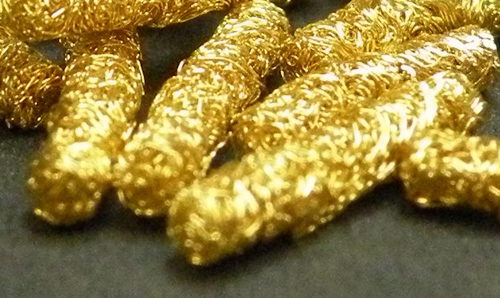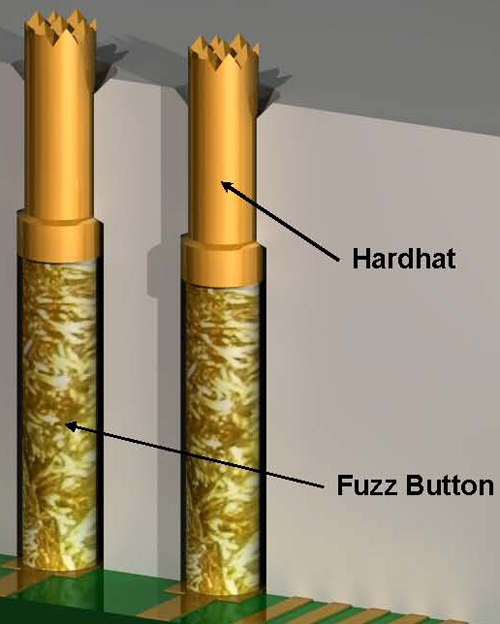
I am always amazed by the creativity of the human mind when confronted by a challenge. In 1960, clever minds at Tecknit, a manufacture of shielding materials, created a unique solution to connect grounding structures to contain EMI (electromagnetic interference.) They formed a fine, hair-thin wire into a disk that, when compressed, connected ground planes together. They used beryllium copper wire for high spring rate and high conductivity, and plated it with gold to provide a reliable interconnect with many mating points.
The “Secret Sauce” is a special manufacturing process that ensures that the wires are formed into the button with a very random distribution of the wire, allowing them to act like many tiny spring contacts. The mass of this button is very low, allowing them to be placed into drilled holes in dielectric material, with good retention during handling and application. These wire columns compress 15-30% upon mating, creating a low resistance connection with unique properties.
This concept evolved into the Fuzz Button connector from Custom Interconnects, based in beautiful Centennial, Colo.

Fuzz Buttons are applied in a wide variety of military, aerospace and RF applications, as well as applications in automotive, medical and test environments. Edward Petsuch, General Manager, describes the company as “small and mighty.” They make buttons on demand to meet the needs of individual customers around the globe. A sweet spot for these array connectors are interposers with buttons on a 1 mm pitch and 0.040 in. thick using Fuzz Buttons in the range of 0.020 in. diameter. Because these kinds of applications are typically low volume, with a high mix of configurations, the dielectric carrier is typically a drilled sheet of high performance plastic like Ultem, Teflon or Torlon.
The nature of this process allows many variations on the theme, making this technology useful for an incredibly wide range of applications.
The prime implementation for Fuzz Buttons is for interposers used to mate parallel surfaces, mating two printed circuit boards, flex circuit to board connections, ceramics, antennas or sensor arrays.
Military applications are rife with high vibration and unfriendly thermal environments. Most of the electronic packages are in containers that seal out the atmosphere, but are subject to high heat and constant vibration. The Fuzz Button contacts are especially well suited for this kind of environment because the wad of fine wires conform to the mating surface and provide many redundant mating points that continue to perform well in high vibration environments. It is REALLY important that military electronics perform well in these hostile environments. Applications include aircraft, drone, missile and vehicle electronics.

Space applications are especially critical. The interconnect must survive the violence of launch and subsequent maneuvers, the intense cold of space and the intense heat of the unfiltered sun on one surface of the spacecraft. You can imagine that the redundancy of many connections is ideal under these adverse conditions. To enable these contacts to perform well, the most common alloy for the wire is Beryllium copper, a material that offers higher conductivity than most common connector alloys, and also provides greater spring force. In addition, it performs over a wider temperature range, both hot and cold, than traditional copper alloys. For extreme environments, like the space application, Custom Interconnect provides variants using gold plated Tungsten, or gold over Nickel Chromium wire.
Many RF applications have special needs as well. Radar arrays, for example, have a field of sensors whose locations are determined by the RF performance of the array, making conventional connectors poorly suited. With Fuzz Button technology, the buttons can be placed in a dielectric material with dimensions that correlate with the sensor array. This can be quite custom. These sensor arrays can be on the ground, airborne, underwater or even in space.
RF signals are most often transmitted through coaxial environments, with a center conductor surrounded by a tube. Think about your TV cable. At some point, the coaxial arrangement must transition into a planar printed circuit board. This electrical transition is quite critical, especially as frequencies become higher. Using discrete Fuzz Buttons can allow for electrically optimized contact locations to smooth the signal transition.

Test socket applications require extraordinarily high mating cycles. To enhance performance in test applications, Custom Interconnect has a large family of “Hard Hat” contacts. These are probe tips placed on top of the Fuzz Button and provide a rigid solid contact point with the device under test. The combination of Fuzz Buttons and the hard hats allow for very high cycle life, up to 500,000 mating cycles, which is important in the test environment.
Cinch, now part of the bel group, offers CIN::APSE contacts that are similar to Fuzz Buttons. Cinch focuses more on the mainstream sizes of 0.020 and 0.040 in. diameter used primarily in socketing and mezzanine applications. They specialize in using gold plated molybdenum wire tuned for high-speed electrical performance even at frequencies above 20 GHz. Cinch also patented an hour glass shaped cavity to improve retention of the contact during handling.
So, If your application requires connections between parallel surfaces for applications requiring either extremely high cycle life (over 500,000 cycles, for example), or extreme temperature and vibration exposure, consider these tried-and-true unique connectors. The substrate (dielectric carrier) can be customized to your requirements for a relatively low tooling cost and low volumes are practical without a huge premium.

Leave a Reply
You must be logged in to post a comment.